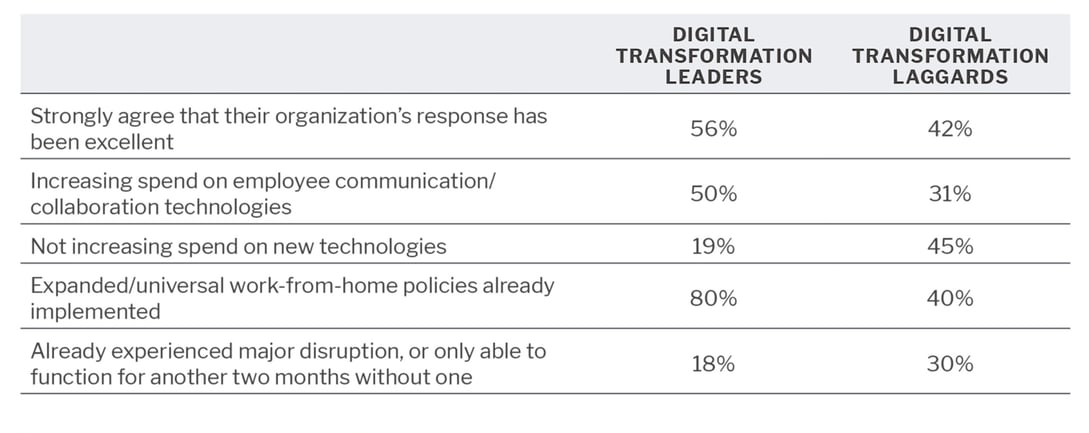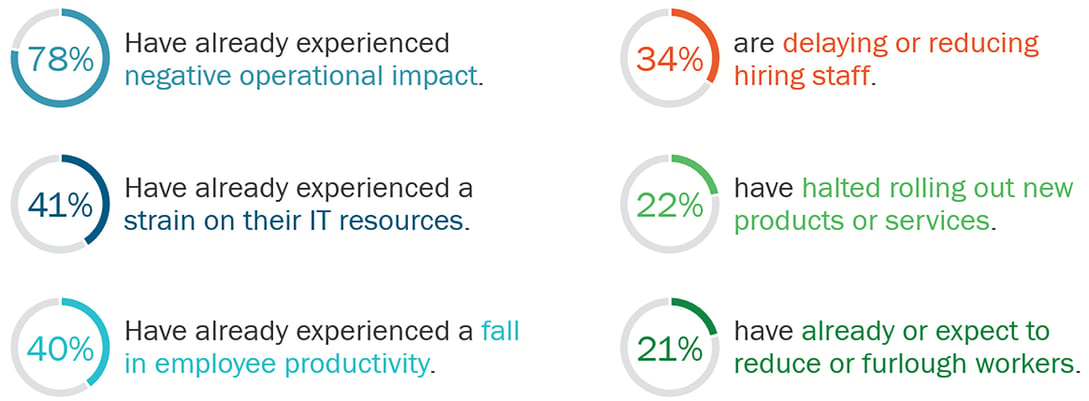
The Coronavirus Impact: 20 Long-Lasting Changes We Expect
The data from our Voice of the Enterprise: Digital Pulse, Coronavirus Flash Survey, which we conducted with over 800 technology decision-makers, paints an extraordinary picture of widespread, severe, and compounding impacts on businesses (see Figure 1). If anything, these will have become more widespread and more severe since we conducted the survey. Grab a copy of the full report and dive into the high-level findings below.
Figure 1: Coronavirus Impacts
Source: 451 Research's Voice of the Enterprise: Digital Pulse, Coronavirus Flash Survey March 2020
Our survey respondents gave varying opinions as to whether the impacts being felt and the policies they were putting in place would be long-term.
- “The longer this goes on, the more challenging it will be to return to prior practices of in-office, travel, third-party visits.” – IT/Engineering Managers and Staff, 10,000+ employees, $10B+, Manufacturing
- “The outbreak may lead to a reversal of recent policy shifts toward in-office work, but that reversal is unlikely to be permanent if it occurs.” – Mid-level Management, 1-249 employees, $1-9.99M, Retail
- “Our clients suffer a slow-down, or may go out of business, and this will eventually have the knock-on effect of staff reduction at my work. Whether this will be temporary or permanent remains to be seen.” – IT/Engineering Managers and Staff, 10,000+ employees, Software and IT Services
- “The long-term impact on our clients and the demand for our services may fall as consumers move to online sales channels.” – IT/Engineering Managers and Staff, 250-999 employees, $10-99.99M, Business Services
- "The long drawn-out recovery in the economy. The damage being done to businesses and employees because of closings and cutbacks will last for 12 months or more.” – 1-249 employees, $10-99,99M, Manufacturing
The 451 Take
As each week goes by, it seems ever more reasonable to assume there will be long-lasting impacts from the coronavirus outbreak. These will include lasting changes in workforce technologies. 451 Research's Workforce Productivity and Collaboration team put on our thinking caps and came up with 20 trends, across three main themes where we expect change to happen: the emergence of a new people management stack, growing emphasis on virtual engagements, and more empowerment at the workforce edge. A common assumption across all the trends we highlight is that the even more disruptively dynamic business environments that existed before the crisis will lead companies to invest in tooling that supports more agile operational models, allowing them to respond more quickly to new threats and opportunities in the post-COVID-19 world.
The case for long-lasting change
Our flash survey data tells us that 27% of all businesses expect to have long-lasting expanded remote work policies, and 16% say limitations on travel will remain in the long term. Our Voice of the Enterprise: Workforce Productivity and Collaboration, Employee Lifecycle and HR 2020 survey reports 30% of employees feeling more engaged in their work since the crisis began – which is a significant proportion who may not want to 'return to normal.'
Whatever the exact impacts, it seems reasonable to assume even after quarantines end, that there will likely be prolonged economic disruption. For many businesses, this will mean knock-on effects on budgets, expansion plans and strategic initiatives. We also believe some of the remote work shifts will likely stick. And finally, new competitive dynamics are already emerging in many industries.
In one sense, this is a continuation of the pre-crisis digital transformation agenda, albeit supercharged and with less predictability. We expect that in some businesses, organizational roadblocks that were previously optional will be removed through necessity. That's because there is diminishing space to hide – inefficient processes, disengaged employees, the lack of productivity, and organizational silos are all problems worsened in the short term, leaving more businesses more vulnerable than they would have been pre-crisis.
Businesses will need operational agility for a long time, even after the immediate crisis abates. Insofar as there will be a new normal, it will involve striving for that agility. This will give an advantage to technology-forward businesses that already have a track record in automating their business processes and digitizing assets. This is already apparent in the initial response to the crisis – our data shows that digital leaders are more likely to be planning and investing to adapt, and implementing mitigation strategies to a greater extent than the digital laggards will. A potentially growing gulf between leaders and laggards may accelerate the pace of change even more (see Figure 2).
Figure 2: Digital Transformation: Leaders and Laggards

Source: 451 Research's Voice of the Enterprise: Digital Pulse, Coronavirus Flash Survey March 2020
The Technology Supply Side has to Respond
In tandem with this changed demand-side dynamic, there will be new opportunities for technology vendors. Elevated demand in the immediate term for offerings that support remote and agile work, however, won't necessarily translate into a longer-term home run. For every vendor, this throws significant complexity into the mix, and because the budgets, across the board, of many businesses will likely be under pressure for some time, no supplier will escape the challenge.
Incumbents may find that market share isn't ballast to new competitive disruptions, although they might conversely benefit from customers doubling down on existing investments. Challengers will find opportunity in being able to move quicker and, whether accurate or not, riffing on the idea that slow-moving incumbents are now, definitively, 'legacy' in the post-crisis 'new world.' They may find, however, that all their category-creating efforts to define the future may need to be, once again, rethought as they now face a new future.
A New People Management Stack
While much of the business impact in the short term has been experienced as disruptions to customer demand, supply chains and workforce layoffs; in the longer term, it will be felt more strongly in the challenges that businesses will have surviving and competing in more dynamic and less predictable competitive environments. It will be crucial for businesses to build in as much resilience and elasticity as possible within their workforce, which is why, in our view, one of the most profound changes will be the emergence of a more joined-up 'people management stack' – from top to bottom, the improved ability to appraise, develop, manage and plan around their skills base.
Advanced scenario modeling as table stakes. With many businesses scrambling to understand impacts, reorient their strategic direction and allocate resources effectively, agile scenario modeling contextualized across business functions will become table stakes in planning software. Power users in financial analysis and planning (FP&A) and corporate performance management (CPM) will demand stronger capabilities for creating and managing contingency plans for a variety of situations. Business leaders across departmental functions will be expected to step up, and be more specifically involved in continuous planning initiatives.
-
Data-driven workforce planning. One of the most disruptive elements of this crisis is proving to be the impacts on the workforce – reductions, furloughs, hiring freezes, employee disengagement, remote working and rapidly revised goal setting. Business leaders will want to make more data-driven decisions around people management, which will accelerate FP&A vendors adding planning functionality for adjacent talent and operations users, and stimulate demand for organizational planning and analytics (OP&A) tools supporting planning "owners" in HR.
-
Resource management democratizes. Resource management will also pass further down the chain, becoming more embedded within a wider range of tooling beyond traditional project management, workforce management and ERP tools. Quickly understanding and responsively managing shifting dependencies between people, their workloads and workflows will become important to optimize available resources, and in times of crisis, respond quickly when the need arises. Operational agility, business continuity and employee engagement (e.g., preventing burnout) use cases for democratized resource management capabilities will take hold.
-
Upskilling and cross-skilling. The war for talent preceding the crisis has inverted – businesses struggled to attract talent, now they can't afford to keep it. More businesses will look to upskill employees and apply those skills across different work initiatives. This continues an existing trend – our Voice of the Enterprise: Workforce Productivity & Collaboration, Work Execution Goals and Productivity Challenges 2019 survey reported 31% of senior managers as saying opportunities to acquire new skills would be one of the best ways to improve their team's overall performance. With a more precarious workforce responding to increasingly complex business demands, businesses will look for tools to understand their skills proficiencies and appraise them in the context of multiple workloads mapping them to specific business needs as required.
-
Regularization of workforce management. The jury will continue to be out on the effectiveness of remote working. Our Voice of the Enterprise: Workforce Productivity and Collaboration, Employee Lifecycle and HR 2020 survey reports 30% of employees feeling much more engaged in their work, and 55% less engaged since the coronavirus outbreak. Businesses will want to regularize expectations across their workforce because a more diverse set of work practices has to coexist. Capabilities like work scheduling and schedule forecasting, predictive attrition analysis and productivity tracking will bleed over from contractor and part-timer management into the main workforce cohort. It's an area already under scrutiny – in the same survey, HR pros reported workforce management tools as in their top three tool types needing improvement, with the lack of intelligence and automation being the key absent capabilities.
-
Employee engagement 2.0. Employee engagement has been emerging as a key metric for the employee experience since before the coronavirus outbreak. Given the strain that employers and employees are under currently (71% pre-crisis already reported finding their jobs stressful), we anticipate acceleration into the next phase for engagement strategies. Version 2.0 will be characterized by a shift from just measuring sentiment through one-to-many pulse surveys and outward recognition of good work well done, to more concerted efforts at culture building, more participative decision-making, and a stronger focus on determining specific engagement drivers for productivity.
Virtual Engagements
In recent months, everyone has become familiar with the term 'social distancing.' As we transition from the old to a new world, social distancing will reflect the decision by businesses to conduct interactions in the virtual world that were previously done in person, or not at all – for reasons of cost, engagement, and productivity, not evasion. Although this will include more video and voice collaboration, the leading edge will leapfrog into new virtual forms of person and machine interactions – the value proposition of which goes beyond remote conversation to more focused productivity gains and user experiences.
-
Real-time communications win big. Digital channels have become be the primary means for customer and employee engagement because for many this has been the only way to remain operational as a result of the COVID-19 quarantine. There will be even more emphasis going forward on the use of real-time chat, messaging, voice, and video communications across customer and employee use cases. As communications channels become more embedded within digital experiences, communications platform as a service (CPaaS) vendors will benefit, including from the angle of demonstrating the scalability and elasticity of the cloud to support business continuity.
-
Video interviews become the new normal. Some businesses froze hiring as an immediate response to the outbreak; some of those who continued turned to video interviews to conduct their initial communication with, and evaluation of, candidates. Our Workforce Productivity & Collaboration, Employee Lifecycle and HR April 2020 survey shows video already in the top five of ways to improve candidate evaluation, up from eighth a year ago. Once implemented, these tools offer scalability and flexibility in the candidate evaluation process that cannot be matched by most HR teams and traditional methods, and in many cases, offer additional analyses of language and facial recognition data that can help hiring managers make a more informed decision. Because of this, we think these tools will stick around for a long time.
- Virtual event technologies will boom. A heavy casualty of the crisis has been in-person events and conferences. Cutbacks in travel and event attendance won't necessarily be overturned as businesses come to realize the financial and productivity costs of significant out-of-the-office travel. Virtual will grow as a long-term format, and new technologies will arise to support this. Standard conferencing and streaming technologies won't suffice for the breadth of presentation, break-out and demonstration use cases events typically include. Tools supporting greater interactive, immersive and, importantly, community-based experiences will emerge.
- Pervasive voice and contactless interfaces. A heavy casualty of the crisis has been in-person events and conferences. Cutbacks in travel and event attendance won't necessarily be overturned as businesses come to realize the financial and productivity costs of significant out-of-the-office travel. Virtual will grow as a long-term format, and new technologies will arise to support this. Standard conferencing and streaming technologies won't suffice for the breadth of presentation, break-out and demonstration use cases events typically include. Tools supporting greater interactive, immersive, and, importantly, community-based experiences will emerge.
-
Video collaboration takes center stage. Video collaboration was gaining ground before the outbreak, but mainly among digital-native users. The quarantine has led to an unprecedented surge in use across all types of users. With a substantial number of organizations anticipating travel restrictions and work-from-home as long-term policies, we expect the use of video technologies to accelerate post-COVID-19.
-
VR breaks out of niche use cases. Although voice and video conferencing will increase, with prolonged use, they will struggle to bridge the gap between digital and real-life meeting experiences where company culture, and team and individual dynamics play a major role. Teleconference tools are not designed to be proxies for real-life interaction, but VR is. As remote work becomes the new norm, VR-powered collaboration tools will support those struggling with the lack of context from voice and video, and needing to improve user engagement, team cohesion, and higher-value brainstorming and decision-making.
-
Security and compliance for business communications. The quarantine has led many organizations to realize that the tools they use for communications and collaboration may not adequately support several use cases, including external collaboration and remote workers. This was already a priority in highly regulated verticals such as finance and government but has become critical across all types of organizations, given the sudden need to support a substantial number of employees working remotely. We expect features such as end-to-end encryption, security settings for hosts and guests, waiting room, and user authentication to become more relevant for these platforms.
An Empowered Edge
The same stimulus that will lead to a more joined-up people management stack, and encourage more virtual engagements, will lead to more empowerment at the edge of the workforce. Disruptively dynamic business environments will accelerate the countervailing force of more agility at the edge across the long tail of workforce processes. Whether it's in no-code workflow automation, the easier synthesis of data across different business systems by non-technical users, new and more flexible digital workspace canvases, or new immersive experiences allowing for more of the whole individual to participate in productivity – a maker-movement vibe will come to characterize productivity software going forward.
-
Collaborative workspaces find their feet. Collaborative workspace applications bringing people, data, documents and workflow together in one experience will gain traction as ways to knit together distributed teams, their ideas, and their applications. They will support employees in recapturing some of the context lost through scaled-back travel, in-person meetings and event attendance; support purposeful and focused collaboration beyond just conversation; and provide the basis for scalable team-based workflows across the workforce long tail that would otherwise be absent across a fragmented estate of different tools. Our Voice of the Enterprise: Workforce Productivity & Collaboration, Work Execution Goals and Productivity Challenges 2019 survey showed that the automatic surfacing of information as a team needs it was the single biggest perceived benefit from automation, according to employees.
-
Visual immersion becomes commonplace. Visually and virtually 'playing' with content can aid ideation, unlock improved decision-making and enhance user engagement. Common remote work tools emphasize scalability and accessibility more than engagement and enhanced productivity. With more employees working remotely, there's the danger that the broader range of working styles and behaviors that need to be supported lowers the bar for productive and engaging experiences, by overemphasizing simplicity and standardization. Some tools will incorporate unique design features enabling more intuitive and engaging interactions; touch screens and stylus pointers, VR headsets, virtual event experiences will, on the flip side, edge toward a generation of more immersive experiences.
-
Legacy companies adopt e-signature. Many progressive or fast-moving companies cannot imagine a world without electronic signature technologies, but the fact of the matter is that many legacy industries, older companies, and smaller organizations were still heavily reliant on paper processes before the novel coronavirus outbreak. The ensuing crisis and call for social distancing left a lot of companies scrambling to put a digital solution in place, some of which were exploring e-signature for the first time. The amount of daily work friction that e-signature products help remove makes them a candidate for software with staying power in the post-coronavirus business world.
-
Frontline workers get more love. The pandemic has put the spotlight on frontline workers – not just emergency responders and healthcare providers, but also grocery store and warehouse employees, truck drivers, and food and grocery delivery gig workers. The current crisis highlights the critical role they play in business continuity, particularly in the distribution and delivery of goods and services. We expect further adoption of technologies, including real-time communications – such as mobile messaging and push-to-talk – and mobile access to back-end applications. This will enable an improved digital employee experience for these workers, and allow organizations to reassess their role in the customer journey.
-
Intranets become more sticky. With some of the remote work sticking after quarantines end, company communication will become trickier, with the combination of less face-to-face and the potential for over-communication through video and messaging platforms. Step up the humble intranet, evolving beyond information broadcasting to become an important point of entry for workers to be more productive in their day-to-day work. Our Voice of the Enterprise: Workforce Productivity & Collaboration, Technology Evaluations 2019 survey showed digital leading businesses more likely to have deployed intranets and to have done so organization-wide. The data also shows latent appetite in particular for a wider range of features, workflow management, reporting capabilities, and integrations with other business applications.
-
New personal-professional crossovers. There will be long-lasting social, psychological, and pragmatic impacts from this crisis that will lead to new personal-professional crossovers in technology usage. Communications platforms previously just used for business purposes will find longevity in personal use cases, more employees will seek their learning platforms to develop greater career resilience, work management platforms will support individuals wanting to better schedule and balance personal and professional commitments, workforce management tools will support employees managing their full-time and other jobs and side-hustles.
-
'Systems of delivery' become mainstream agile. Post-COVID-19 business competitiveness will be even more about the ability to innovate and respond to markets and customers. Two opposing forces – the continuing expansion of the application estate and businesses' demand for improved productivity across that estate – will birth the next big shift in enterprise software: new 'systems of delivery' or singular planes uniting strategy, planning, resource and skills management, and work execution. This shift will embody the strategy and intellectual property of the business itself by providing a more agile operational model, catalyzing new ways of organizing functions and lines of business, and mainstreaming agile practices workforce-wide.
Analysts: Chris Marsh, Raul Castanon-Martinez, Conner Forrest, Rosanna Jimenez
Published on Tuesday, April 21 2020 | © 2020, 451 Research, LLC - A division of S&P Global Market Intelligence Using Interactive Document Server technology from Publish Interactive
/Ripcord%20Logo%20-%20Color%2011.png?width=2000&height=620&name=Ripcord%20Logo%20-%20Color%2011.png)





